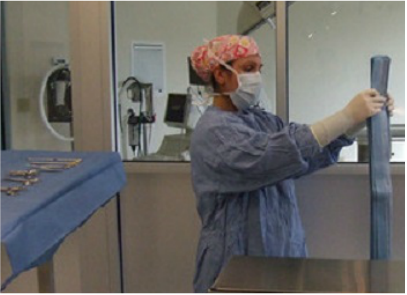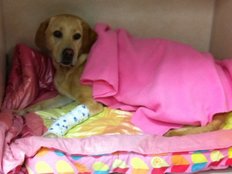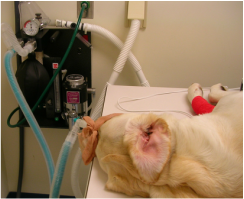Anesthesia Safety |
|
The medical team at Stratham-Newfields Veterinary Hospital is committed to client education and patient safety;
therefore we recommend asking the following questions before allowing anyone to anesthetize your pet.
therefore we recommend asking the following questions before allowing anyone to anesthetize your pet.
Q. Will my pet be examined the morning of surgery?A. Your veterinarian at SNVH will give your pet a thorough physical examination the morning of the procedure to make sure he/she is healthy enough for the surgery and anesthesia. Remember, pets can't tell us if they don't feel well. A physical examination is our first defense against performing surgery on an animal that could be ill, have an infectious disease, a heart murmur, or could be debilitated from parasites.
|
Q. Will pre-anesthetic blood work be done?A. All patients who are anesthetized will have blood work beforehand. All pets--not just the old or sick--should have a basic pre-anesthetic blood test to reduce risk and increase safety. A healthy-appearing pet may be hiding symptoms of a disease or ailment, and blood work can detect abnormalities that could affect anesthesia--even in pets younger than one year of age. We check a complete blood count (CBC), blood sugar, liver and kidney values, and a complete biochemical profile of 25+ components including electrolytes. If the blood work is normal, we can proceed with confidence knowing the anesthetic risk is minimized. These tests also provide a baseline for your pet in case illness occurs in the future.
|
Q. What kind of anesthesia will my pet receive A. No single anesthetic agent is best for all patients--there is no
"one size fits all." Factors such as the patient's age, breed, and health determine which anesthetic protocol is most ideal. At SNVH, we also use the pre-anesthetic examination, blood work, and the type of procedure to select the best anesthetic for each patient. All patients receiving a general anesthetic will have a new, sterile breathing tube (endotracheal tube) placed in order to keep the airway open and allow for supplemental oxygen or gas anesthesia as needed. A new, sterile tube for every patient is actually very rare; most veterinary hospitals rinse and reuse the endotracheal tubes until they eventually fail. We would never want that for your pet! |
Q. Are the surgical instrument packs sterilized separately for each patient or is the same pack used for multiple surgeries?A. Every patient at SNVH always receives fresh, sterile packs. Believe it or not, there are practices that re-use the same surgical pack on more than one patient. Some practices soak their instruments in a disinfectant solution rather than fully sterilize them in an autoclave (a special chamber that increases heat and pressure to sterilize instruments). At SNVH, each surgical patient has an autoclave-steam-sterilized surgical pack.
|
Q. Does the surgeon use sterile surgical attire?A. At SNVH, the answer is yes. Although most people assume that all surgeons don a sterile gown and gloves and wear a cap and mask for surgery, that is unfortunately not the case. While it does increase surgical costs to use complete sterile surgical attire, the consequences of not doing so is increased risk of infection and harm to the pet.
|
Q. Will my pet have an IV catheter in place before, during, and after anesthesia?A. Every patient anesthetized will have an IV (intravenous) catheter in place before, during, and until your pet is well awake and recovered from the anesthesia. Intravenous catheters allow us to administer medications to your pet while keeping them more comfortable, and they give us instant access to a vein if an emergency arises during
anesthesia--when every second counts. Fluids are also administered through the catheter to your pet during anesthesia (see below). |
Q. Will my pet receive IV fluids during anesthesia?A. Every form of anesthesia tends to lower blood pressure which can be harmful to the body and organ function. IV fluids help to maintain proper blood pressure. At SNVH, your pet will receive IV fluids using a specialized fluid pump that allows us to deliver precise amounts and change the rate as needed.
|
Q. What monitoring techniques will be used during the anesthesia?A. At SNVH, your pet's vital signs will be monitored by a Credentialed Veterinary Technician as well as electronic patient monitors throughout the entire procedure. The patient monitors will be attached to your pet and will continuously measure heart rate, ECG, respiratory rate, body temperature, the amount of oxygen in the blood (pulse oximetry), the amount of carbon dioxide (end-tidal CO2), and blood pressure. The most important monitoring tool we have is a Credentialed Veterinary Technician dedicated exclusively to your pet while anesthetized. This individual is very "hands on" and will be assessing your pet's heart rate, respiratory rate, gum color, and depth of anesthesia with their hands, ears, and eyes--not just relying on the monitor. Vitals are charted on paper every few minutes.
|
Q. Is my pet's body temperature monitored and controlled during and after anesthesia?A. All pets, especially cats and smaller dogs, lose a lot of body heat while anesthetized. The resulting hypothermia can cause a life-threatening slowing of the heart and can also slow the anesthetic recovery. For this reason warmth should be provided and body temperature should be monitored regularly during and after anesthesia.
At SNVH, in addition to monitoring your pet's body temperature, we use a heated surgical table, a special blanket that has warm water circulating through it, and thick towels and fleece in order to keep your pet warm and cozy during the procedure. This keeps the temperature up during and after surgery and provides a smoother, safer, and more comfortable recovery for your pet. |
Q. How will pain be controlled for my pet?A. There are significant differences in anesthesia and pain control techniques among veterinarians. Studies show that pain control is much more effective if begun ahead of the procedure. At SNVH, a specific combination of pre-medications selected for your pet will be administered in order to alleviate discomfort and stress and will also reduce the amount of anesthesia necessary for your pet—a huge safety benefit. Since anesthesia doesn't control pain once the pet wakes up, we administer a variety of additional medications to relieve operative pain.
|
Q. Will I be given post-surgical instructions?A. At SNVH, a doctor or nurse will review detailed, written discharge instructions with you at dismissal. We don't expect you to have to remember everything we say, so we write it down for you, and you can always call us! Most surgical patients are seen 10-14 days post-operatively at no cost to you in order to ensure a healthy surgical site and to address any concerns you might have.
|
Please visit our Surgical Services and Pain Management pages to learn how our experienced and caring team
can provide your pet with a safer and more comfortable surgical experience.
can provide your pet with a safer and more comfortable surgical experience.
While affordability is obviously a concern, price shopping is not the safest thing
for your pet when it comes to veterinary care.
If you are finding an extreme price difference between two veterinarians, there is usually a reason for the difference. There is NO state regulation of veterinary care in the state. You need to be aware of what services are included in the cost of the procedure. Many veterinarians don't include services such as pain medication, pre-anesthetic blood work, balanced pre-surgery medications, intravenous catheters, fluids during anesthesia, and monitoring during and after the procedure into the general cost of the surgery.
All blood panels are not equal; some may test 1-4 parameters, while others are a complete panel with over 50 values. This helps in avoiding any hidden problems. All pain medication is not equal either. For example, Torbugesic only provides pain relief for about 20-30 minutes and would be worn-off by the time the patient awoke from surgery, yet is still frequently misused as adequate pain control.
Before surgery, owners should take the time to sit down with their veterinarian and ask questions about the procedure and the steps that will be taken to ensure their pet's safety while under anesthesia. Your veterinarian should be able to answer questions about how your pet's vital signs will be monitored while under anesthesia and who will be responsible for monitoring your pet.
for your pet when it comes to veterinary care.
If you are finding an extreme price difference between two veterinarians, there is usually a reason for the difference. There is NO state regulation of veterinary care in the state. You need to be aware of what services are included in the cost of the procedure. Many veterinarians don't include services such as pain medication, pre-anesthetic blood work, balanced pre-surgery medications, intravenous catheters, fluids during anesthesia, and monitoring during and after the procedure into the general cost of the surgery.
All blood panels are not equal; some may test 1-4 parameters, while others are a complete panel with over 50 values. This helps in avoiding any hidden problems. All pain medication is not equal either. For example, Torbugesic only provides pain relief for about 20-30 minutes and would be worn-off by the time the patient awoke from surgery, yet is still frequently misused as adequate pain control.
Before surgery, owners should take the time to sit down with their veterinarian and ask questions about the procedure and the steps that will be taken to ensure their pet's safety while under anesthesia. Your veterinarian should be able to answer questions about how your pet's vital signs will be monitored while under anesthesia and who will be responsible for monitoring your pet.













